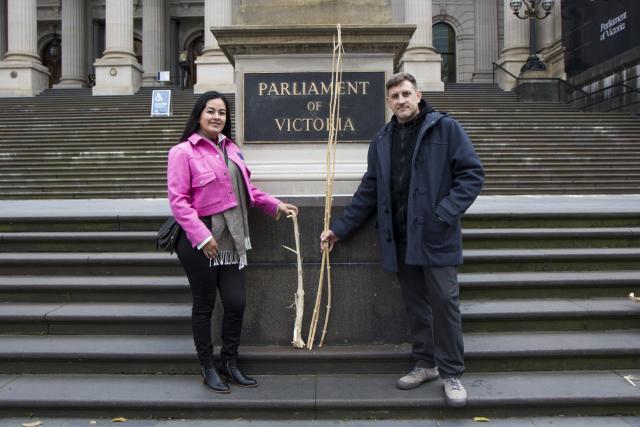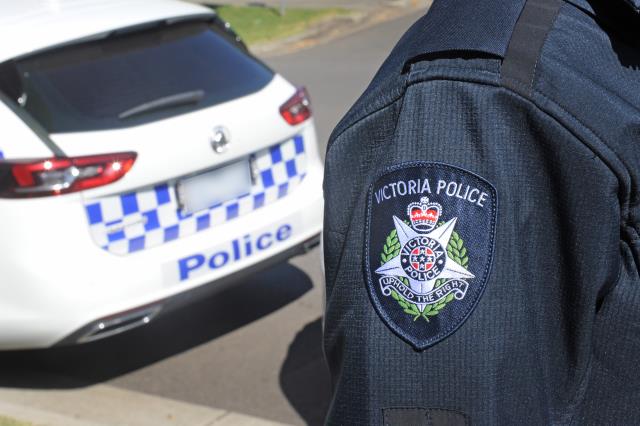South East hemp producers joined Legalise Cannabis Victoria in Parliament on Wednesday 31 May to push for an inquiry into Victoria’s industrial hemp industry which they hope will give the trade a much needed boost.
The motion was successfully passed, bringing new interest into the future of industrial hemp production.
OneLife Botanicals cultivators Mark Smith and Ruth Cardenas and Hexcore Hemp Processing hemp innovator and founder Brett Boag were among those involved.
“I think historically there has been a lot of bad press around hemp and there’s been no one speaking as an advocate for it,” Mr Boag said.
“It’s tremendous for us all in the hemp industry.
“I’m looking forward to seeing what the outcomes are.”
Mr Boag works with industrial hemp, which he says “in some applications rivals steel”.
“As an industrial material it’s far superior to so many products and people don’t even know about it,” he said.
“Any kind of timber products made of hard or soft wood, hemp is harder.
“It has no equal in terms of its mechanical and physical strength.”
Mr Boag also stressed the yield potential of hemp in comparison to timber, and how the by-products of hemp production can be used to make things like bowls and cups.
“It takes 25 years at best for pine to be grown, trimmed down, and turned into housing timber, and only 60 per cent of the tree is usable as housing timber,” he said.
“Hemp however, takes 90-100 days to achieve the same result and can be used for anything that timber can be used for.
“In that same hundred days, it sequesters more carbon than a forest does.”
Mr Smith of OneLife Botanicals, a cultivator and manufacturer of medical cannabis, said he was excited to see the hemp industry add to job growth in Victoria.
“Currently all industry in Australia, particularly in VIctoria, is starting to fail, so we need work, we need jobs and growth,” he said.
Mr Smith emphasised Australia’s rich hemp history, with production of the plant dating back to the First Fleet.
“The stigma that’s attached to hemp has not allowed it it’s rightful place,” he said.
“230 years ago, we were growing hemp as a Federation of the Commonwealth.”
Mr Smith said the OneLife team were thrilled the motion for the inquiry passed.
“I think it’s wonderful, it gives us a chance at actually building this industry,” he said.
“Let’s make hemp normal.”
Mr Smith and Ms Cardenas also run OneLife Hemp, a learning environment for students to engage with with hemp.
“We’re trying to encourage students, getting them familiar with the plant and understanding it,” Mr Smith said.
“The seeds are eventually used in the medical facility.”
Those involved in the inquiry believe a state government funded boost to the hemp industry will guarantee more jobs across Victoria, increase the state’s export earnings and contribute to statewide carbon emissions reductions.
“With an estimated global value of $4.9 billion dollars, it is time to shine a light on this incredibly versatile, resilient, and sustainable crop,” said South Eastern Metropolitan and Legalise Cannabis Victoria MP Rachel Payne.
“Hemp’s ability to absorb more carbon dioxide per hectare than a forest or almost any other commercial crop will be crucial in helping Victoria reach its carbon emissions reductions targets.
“We know hemp is grown for beauty products, paper, food and clothing but the construction material capability of hemp alone will be key as Victoria continues to grow.”
Australia’s national hemp farmgate is worth just $15 million and according to AgriFutures the Australian hemp industry “is in its infancy, notably trailing Canada, China and the European Union in terms of scale and value of production.”
By comparison, Canada’s hemp industry is worth $587 million with projections reaching $2.4 billion by 2030.
Key hemp stakeholders will meet in June for the Fibre Forum in Geelong, illustrating growing support for Victorian hemp.
Western Metropolitan and Legalise Cannabis MP David Ettershank said industrial hemp is often “caught in the crossfire” of the prohibition on Cannabis.
“Victorian farmers are crying out to get a foot in this fertile international market, so it’s now time Victorian Hemp is given a chance to thrive,” he said.
In a 2022 study published in Heliyon, researchers found hemp to be a “very promising renewable resource including its potential uses in paper, textiles, composites, biofuel, and food industry”.
“Hemp proves competency in the search for new sustainable resources because it is naturally resistant to disease and pests, conserves water, degrades quickly, and produces environmentally friendly industrial products such as biodiesel, bio-concrete, bio-composite, paper, textile, and so on,” the researchers wrote.
“With the advancement and adaptation of fitting technology, exploitation of the entire physical, chemical and morphological characteristics of hemp can better contribute to a clean, healthy, and sustainable planet.”
Hemp may offer a sustainable alternative to help decrease the cement content of building material, which is the world’s single biggest industrial cause of carbon pollution, according to Beyond Zero Emissions.
Cement production makes up eight per cent of all global carbon emissions.
Hemp paper is has more “recyclability” than wood and produces a greater yield.
Researchers say these features make hemp an important resource to “slow down the deforestation process”.
Hemp also acts as an air purifier, absorbing carbon dioxide and cleaning the air we breathe.
For every tonne of hemp produced, 1.63 tonnes of carbon is removed from the air, making hemp cultivation even more efficient at oxygen production than agroforestry, according to Hemp Foundation Co-Founder Vishal Vivek.
“From nutrition to building material, from clothing to biofuel, from ship sails to bioplastic – you name it and some part of the hemp plant can yield that,” he said.
The pressure on the Andrew’s government to shine a light on the hemp industry came after the state budget announced the imminent closure of Victoria’s native logging industry.
“The foreclosure of native logging makes a hemp inquiry critical so that Victoria can meet its growing need for building materials and fibre pulp,” Ms Payne said.
The Greens have also welcomed the end of native logging, saying it is about time the government realised the industry is “completely unsustainable”.
Deputy Leader of the Victorian Greens, Ellen Sandell, said the writing had been on the wall for native forest logging in Victoria for some time now.
“For too long Labor has given millions of taxpayer dollars to the logging industry to destroy our precious native forests,” she said.
“After years of campaigning and court cases by environment groups, the Greens and local community members, Labor has finally come to the realisation that logging is unsustainable.
“This is a win for all the environment groups, local community members and Greens who have fought to protect our native forests from logging and against a Labor Government who have been dragged kicking and screaming to this position.”
Earlier this year, the Greens introduced a bill before parliament to create legislation by June to bring native logging to a halt.
Australian Greens spokesperson for forests, Senator Janet Rice says it’s now up to the Albanese government to follow Victoria’s lead.
“The Regional Forest Agreements have allowed reckless destruction of native forests for decades across Australia, pushed native wildlife to the brink of extinction, endangered our water supplies, heightened bushfire risk, and made the climate crisis worse,” she said.
“Native forest logging is a dying industry and there’s no way around it.”







